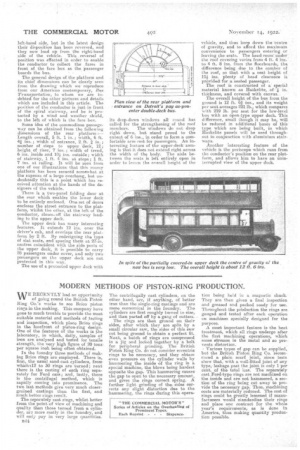A PAY-AS-YOU-ENTER DOUBLE-DECK BUS.
Page 27

Page 28

If you've noticed an error in this article please click here to report it so we can fix it.
A New Design from America which Embodies Several Novel Features.•
I N another part of this issue we deal at some length with the trend in design of motorbus chassis in America, and we indicate therein that, in spite of a handicap of many years, American manufacturers are making bold efforts to overtake builders in this country. American builders have profited from the progressive experience of their British confreres, and in some directions, like the pupil that amassed -knowledge beyond the scope of his master, they have passed those from whom they have derived many of their conceptions.
An indication of this progression is forthcoming from the design of the latest low-floor, pay-as-von-enter double-deck bus which has recently been put into service in Detroit. The design embodies interesting features, notable amongst which are the use of a fare box on the rear platform, a semi-covered top deck, and a periscope which provides the conductor with a view of the upper deck.
A point in the design of the bus which will appeal to the conductor most, is, of course, the pre-payment of fares, which eliminates the necessity for his touring the bus to collect the fare every time
a passenger boards the vehicle, whilst that which will .hold most interest for Many passengers is the semi-covered upper deck ; this feature should not be without interest to motorbus owners, since it enables the most remunerative return to be obtained from each and every vehicle, irrespective of the prevailing weather conditions.
The design of the rear chassis platform of the latest double-decker has been entirely changed from the conventional design, which has hitherto been used in the City of Detroit. The steps to the upper deck on the old type of bus lead up the left-hand side, but in the latest design their disposition has been reversed, and they now lead up from the right-hand side of the vehicle. This reversal of position was effected in order to enable the conductor to collect the fares in front of the fare box as the passenger boards the bus.
The general design of the platform and its chief dimensions can be clearly seen from the drawing which we reproduce from our American contemporary, .73/0 TransporAntiou, to whom we are indebted for the other pictures and details which are included in this article. The position of the conductor is just in front of the spiral stairway, and be is 'protected by a wind and weather shied, to the left of which is the fare box.
Some idea of the commodious passageway can be obtained from the following dimensions of the rear platform:— Length overall, 5 ft. 1 in.; width, 6 ft.
q ins.; width of entrance, 2,1t. in.; number of steps to upper deck, 12 ; height of riser, 7 ins. ; width of tread,
6 ins, inside and 10 ins, outside; width of stairway, 1 ft. 4 ins, at steps ; 1 ft.
7 ins, at railing. It will be seen from one of our illustrations that this roomy platform has been secured somswhat at the expense of a large overhang, but undoubtedly this is a point which has received attention at the hands of the de• signers of the vehicle.
There is a two-panel .folding door at the rear which enables the lower deck to be entirely enclosed, One set of doors encloses the street entrance to the platform, whilst the other, at the left of the conductor, closes, off the stairway leading to the upper deck.
The upper deck has many interesting features. It extends 12 ins, over the driver's cab, and overlaps the rear platform by 2 ft. By redesigning the typs of slat seats, and spacing them at 27-in, centres coincident with the side posts of the upper deck, it is possible to carry 28 passengers under cover, and only two passengers on the upper deck are not protected in this way.
The use of a protected upper deck with
its drop-down windows all round has called for the strengthening of the roof
members. The windows do not drop right down, but stand proud to the extent of 6 ins,, in order to form a comfortable arm-rest for passengers. An interesting feature of the upper-deck awning is that it does not extend right across the width of the body. The aisle between the scats is left entirely open in order to lessen the overall height of the
vehicle, and thus keep down the 'centre of gravity, and to afford the maximum convenience to passengers entering or leaving the seats. The head-room'turder " the roof covering varies from 4 ft. 4:ins. to 4 it. 8 ins, from the floorboards, the difference being due to the camber of the roof, so that with a sent height of 11i. ins, plenty of head clearance is provided! for a seated passenger.
The roof is constructed of a, special material known as HaSkelite, .of' in. thickness, and covered with canvas.
The overall height of the bus from the ground is 12 ft. 61 ins., and its weight per seat averages 221 lb., which compares with 219 lb. per seat for the low-level bus with an open-type upper deck. This difference, small though it may be, will be reduced in additional buses of this type which are being built, in which Haskelite panels will be used throughout in conjunction with aluminium stairways.
Another interesting feature of the vehicle is the periscope which runs from the conductor's position on the rear platform, and allows him to have an uninterrupted view of the upper deck.
































